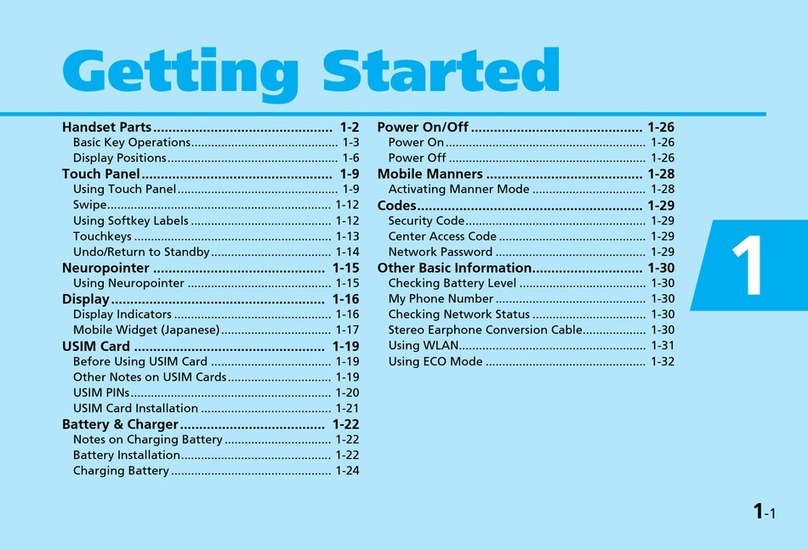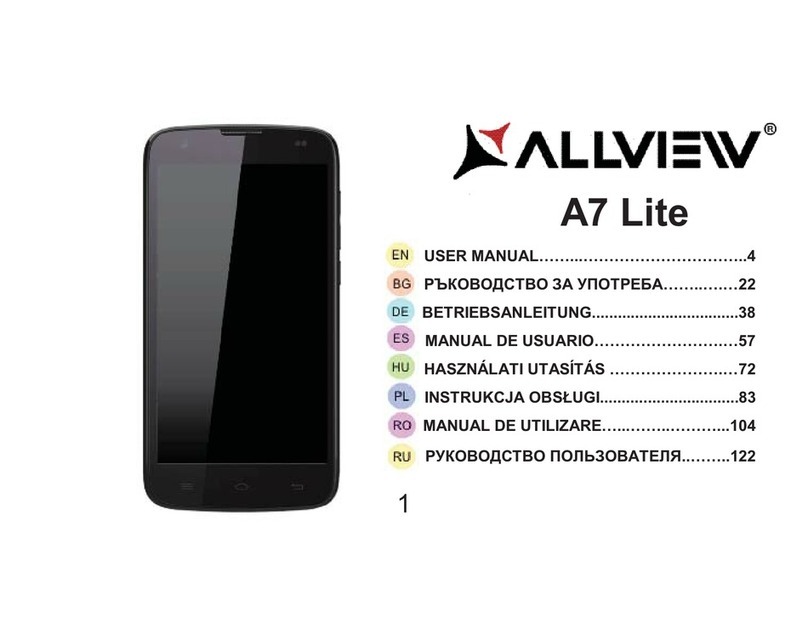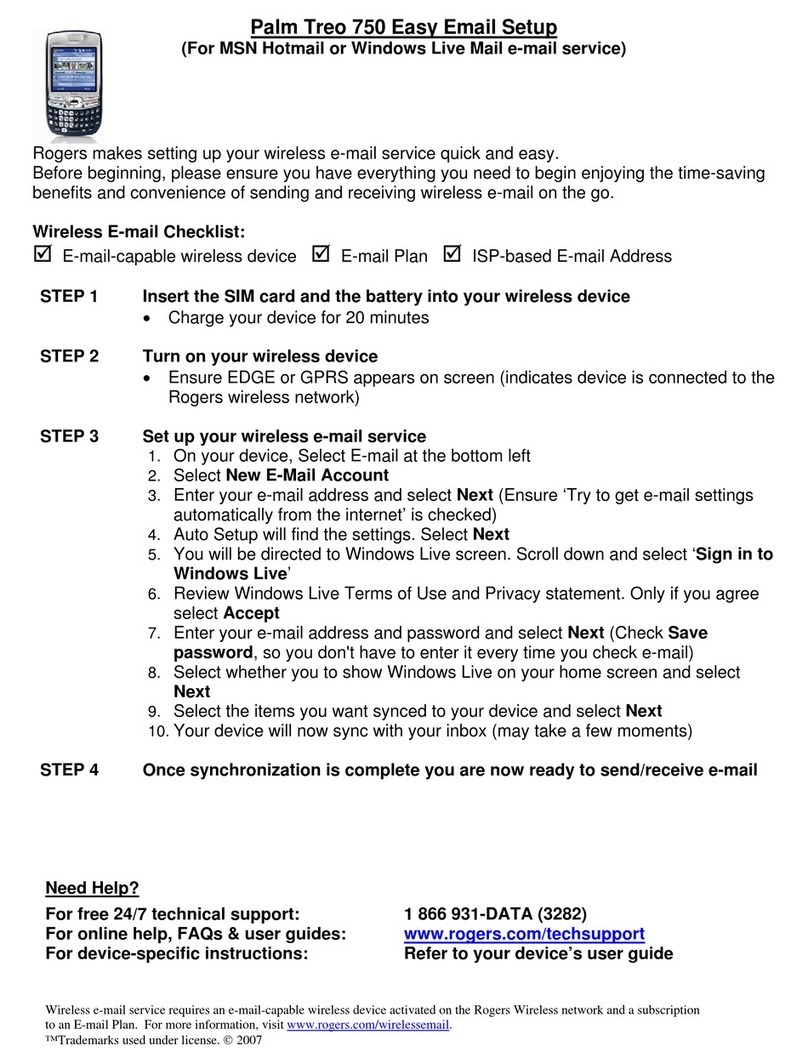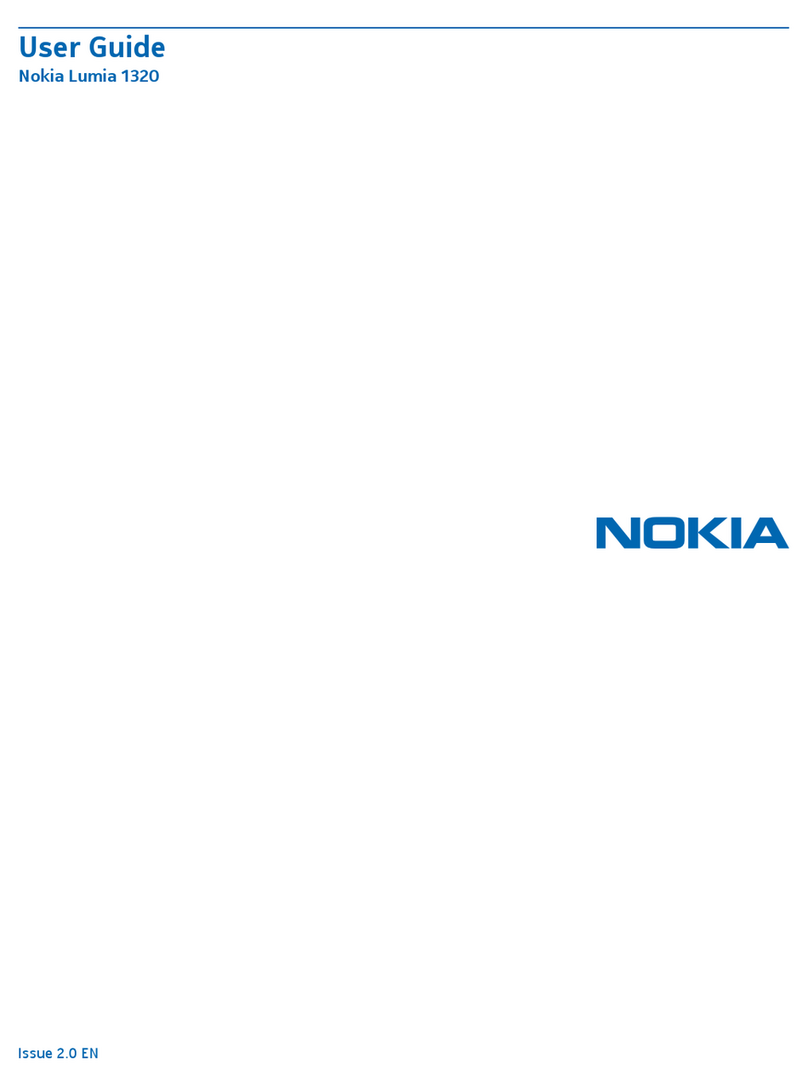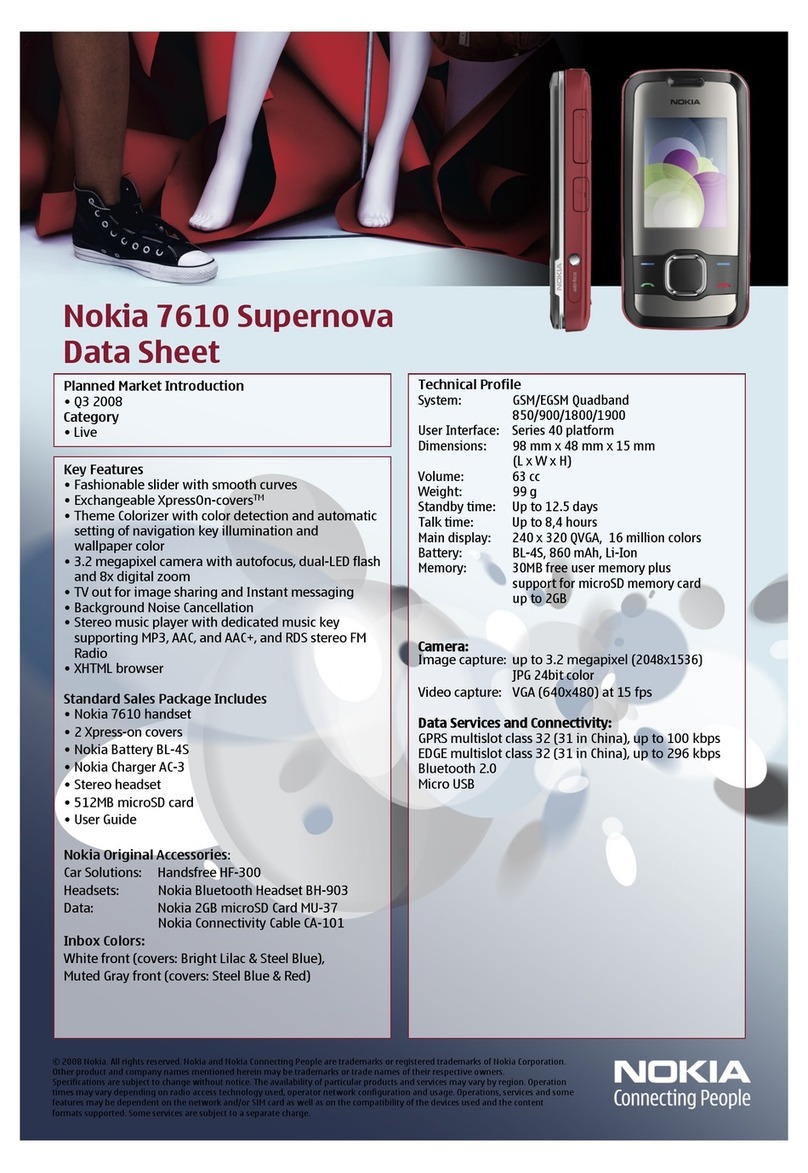Telguard TG-1 Express CDMA User manual

TELGUARD®DIGITAL
TG-1
RESIDENTIAL PRIMARY CELLULAR
ALARM COMMUNICATOR
INSTALLATION AND OPERATING
INSTRUCTIONS
COMPANY CONFIDENTIAL
For use by TELGUARD®customers only.
Distribution to other parties strictly
prohibited.
August 17, 2017

56050801 - Rev B i © 2017 Telguard
Important Note
The registration form must be completed before leaving for the job site to
install the Telguard product. Use our dealer site at www.telguard.com to register
the unit in real time.
Foreword
Dealers purchase Telguard®cellular communicators for the quality, features and
total value they represent. The Telguard TG-1 model (part #s TG1LA002B) is UL
Listed for Household Burglary systems, Household Fire systems, Commercial
Burglary and depending on the model, Commercial Fire systems. The Telguard TG-1
model may be used in Household Burglary systems, Household Fire systems or
combined Household Burglary & Fire systems as the primary communication path.
Technical Support
Technical support for all Telguard products is available:
Monday-Saturday 8am-8pm ET
Toll Free: 800-229-2326, option 9
About this Manual
This manual assumes that you have basic security system installation skills such
as measuring voltages, stripping wire, properly connecting wires together,
connecting wires to terminals, and checking phone lines. It also assumes that
you have a familiarity with the proper installation and programming tasks related
to various alarm panels.
The material and instructions covered in this manual have been carefully checked
for accuracy and are presumed to be reliable. However, Telguard assumes no
responsibility for inaccuracies and reserves the right to modify and revise this
manual without notice.
It is our goal at Telguard to always supply accurate and reliable documentation.
If a discrepancy is found in this documentation, please mail or fax a photocopy
of the corrected material to:
Telguard Technical Services
3225 Cumberland Blvd
Suite 300
Atlanta, GA USA 30339
Fax: 678-945-1651

56050801 - Rev B ii © 2017 Telguard
Repair and Warranty
If you experience trouble with the Telguard Cellular Alarm Communicator
please contact Telguard Technical Support for trouble shooting, repair
and (or) warranty information. The dealer or end user should not
attempt any repair to the Telguard Cellular Alarm Communicator. Repair
of this equipment should only be referred to qualified technical
personnel.
Telguard will repair or replace (our option) inoperative units for up
to two years from date of manufacture. This excludes damage due to
lightning or installer error. Unauthorized modifications void this
warranty. Not responsible for incidental or consequential
damages. Liability is limited to price of unit. This is the exclusive
warranty and no other warranties will be honored, whether expressed or
implied.
An RMA must be assigned before returning product. You may obtain an RMA
via phone at 800-229-2326 option 1, or via email at
Note: RMA number must be on the outside of box or product will not be
accepted.
Future Testing and Limitations on Use
The Telguard TG-1 is part of an advanced design alarm communication
system. It does not offer guaranteed protection against burglary and
fire. Any alarm communication system is subject to compromise or
failure.
The Telguard unit will not work without power. Electrically powered
devices will not work if the power supply is off for any reason,
however briefly.
The cellular radio network, needed to transmit alarm signals from
protected premises to a central monitoring station, may be inoperable
or temporarily out of service. Cellular radio networks are also
subject to compromise by sophisticated methods of attack.
This equipment, like any other electrical device, is subject to
component failure. Although this equipment is designed to be long
lasting, the electrical components could fail at any time.
Due to these limitations, we recommend that if the automatic self-test
feature is not enabled, other arrangements be made with the user to
test the system at least once every three months. Moreover,
arrangements should also be made for on-site inspection/test by a
licensed alarm installer at least once each year.
Terms and Conditions for Use of Telguard Product
These Terms and Conditions are a legal contract between you and
Telguard for the title to and use of the Product. BY RETAINING AND
USING THE PRODUCT YOU AGREE TO THE TERMS AND CONDITIONS INCLUDING
WARRANTY DISCLAIMERS, LIMITATIONS OF LIABILITY AND INDEMNIFICATION
PROVISIONS BELOW. IF YOU DO NOT AGREE TO THE TERMS AND CONDITIONS, DO
NOT USE THE PRODUCT AND IMMEDIATELY RETURN THE UNUSED PRODUCT FOR A
COMPLETE REFUND. You agree to accept sole responsibility for any
misuse of the Product by you; and, in addition, any negligent or
illegal act or omission of your or your agents, contractors, servants,
employees, or other users of the Product so long as the Product was
obtained from you, in the use and operation of the Product.

56050801 - Rev B iii © 2017 Telguard
INDEMNIFICATION OF TELGUARD
YOU SHALL INDEMNIFY, DEFEND AND HOLD HARMLESS TELGUARD FOR ANY OF THE COST,
INCLUDING REASONABLE ATTORNEYS’ FEES, AND FROM CLAIMS ARISING OUT OF YOUR, YOUR
CLIENTS’ OR OTHER THIRD PARTIES’ USE OR OPERATION OF THE PRODUCT: (i) FOR MISUSE
OR IN A MANNER NOT CONTEMPLATED BY YOU AND TELGUARD OR INCONSISTENT WITH THE
PROVISIONS OF THIS MANUAL; (ii) IN AN ILLEGAL MANNER OR AGAINST PUBLIC POLICY;
(iii) IN A MANNER SPECIFICALLY UNAUTHORIZED IN THIS MANUAL; (iv) IN A MANNER
HARMFUL OR DANGEROUS TO THIRD PARTIES; (v) FROM CLAIMS BY ANYONE RESPECTING
PROBLEMS, ERRORS OR MISTAKES OF THE PRODUCT; OR (vi) COMBINATION OF THE PRODUCT
WITH MATERIAL, MODIFICATION OF THE PRODUCT OR USE OF THE PRODUCT IN AN
ENVIRONMENT NOT PROVIDED, OR PERMITTED, BY TELGUARD IN WRITING. THE PARTIES
SHALL GIVE EACH OTHER PROMPT NOTICE OF ANY SUCH COST OR CLAIMS AND COOPERATE,
EACH WITH THE OTHER, TO EFFECTUATE THIS INDEMNIFICATION, DEFENSE AND HOLD
HARMLESS.
WARRANTY and LIMITATIONS
TELGUARD WILL REPAIR OR REPLACE (OUR OPTION) INOPERATIVE UNITS FOR UP TO TWO
YEARS FROM DATE OF MANUFACTURE. EXCLUDES DAMAGE DUE TO LIGHTNING OR INSTALLER
ERROR AS WELL AS UNITS THAT INCORPORATE MATERIAL, OR USED IN A MANNER OR
ENVIRONMENT, NOT SPECIFICALLY AUTHORIZED IN THIS MANUAL. UNAUTHORIZED
MODIFICATIONS VOID THIS WARRANTY. NOT RESPONSIBLE FOR INCIDENTAL OR
CONSEQUENTIAL DAMAGES. LIABILITY LIMITED TO PRICE OF UNIT. THIS IS THE
EXCLUSIVE WARRANTY, IN LIEU OF ALL OTHER WARRANTIES INCLUDING IMPLIED WARRANTIES
OF MERCHANTABILITY, TITLE, DELIVERY, INFRINGEMENT OR FITNESS FOR A PARTICULAR
PURPOSE AND NO OTHER WARRANTIES WILL BE HONORED, WHETHER EXPRESSED OR IMPLIED.

56050801 - Rev B iv © 2017 Telguard
Table of Contents
Important Note i
Foreword i
Table of Contents iv
General Description and Operation 1
Features 2
Operating Mode 2
Multiple Alarm Format Support 2
Complete Supervision of Communication Path 2
Complete Power Supervision 3
Telguard Automatic Self-test Report 4
Telguard Remote Query Capability 4
Programmable Supervisory Trip Output (STC) Relays 4
Diagnostic and Status LEDs 4
Optional DC Operation (12VDC) 5
Complete Factory Reset Option 5
UL and ULC Listings 5
Getting Ready 6
Dealer Account Establishment 6
Pre-Installation Checklist 6
Installation 7
Summary 7
Step 1: Register the Telguard Unit 7
Step 2: Locate Unit and Measure Signal Strength (RSSI) 8
Step 3: Program, Activate & Transmit Alarms over Cellular Network 10
Step 4: Connect Supervisory Trip Outputs 11
Step 5: Connect and Test the Trip Input (optional) 12
Step 6: Complete the Telguard Installation 12
Appendix 1 – Connection Guide 13
Wiring Diagrams 13
Jack Assignments 14

56050801 - Rev B v © 2017 Telguard
Main Terminal Strip Pin Assignments 14
DC Terminal Strip Pin Assignments 14
A/C Terminal Strip Pin Assignments 14
Compatible Alarm Panels 15
Appendix 2 – Troubleshooting Guide 16
LED Indicator Guide – Normal Operating Mode 16
LED Indicator Guide – RSSI Mode 17
Troubleshooting Quick Reference Table 18
Appendix 3 – Detailed Specifications 19
Dialer to Interface Electronics 19
Power 19
Digital Cellular Radio 19
Appendix 4 – Accessories 20

56050801 - Rev B 1 © 2017 Telguard
General Description and Operation
The TelguardTG-1 (Part # TG1LA002B) is a digital cellular radio alarm
transmission device used to provide a primary transmission path (cellular) for
Household alarm panels.
When transmitting an alarm signal, the Telguard obtains its data from the Household
alarm panel by way of a telephone interface. The Telguard will obtain all alarm
signal information including monitoring station phone number, account number and
all zones for every alarm transmission. The Telguard handshakes with the alarm
panel causing it to transmit the alarm data. The Telguard encodes the alarm data
and transmits to the Telguard Communication Center (TCC) over the digital cellular
network. The TCC performs a function similar to a central station receiver and
issues the transmission acknowledgement when the last message in the transmission
is received. After decoding and reformatting, the alarm signal is routed to the
appropriate alarm company monitoring station for action.
In a typical alarm installation, the Telguard is installed in the same area as the
Household alarm panel and is connected directly to the Household alarm panel via
Telguard's RJ-45 jack. Two programmable System Trouble Condition (STC) relays
provide supervisory trip outputs for connection to the alarm panel’s trip zone
input terminals in order to provide a Telguard trouble signal to the alarm panel.
Additionally, automatic self-test and remote query signals are transmitted
exclusively over the cellular network with all Telco line and cellular monitoring,
switching and supervisory functions built in. No extra modules are required. The
Telguard has its own power supply which keeps the Telguard battery charged.
The UL Listed equipment at the TCC plays a key role in the operation of every
Telguard. All Telguards utilize the TCC due to the panel alarm signal format
encoding and decoding requirements used in packet-data transmissions over the
digital cellular network. The TCC also manages the real-time databases for
cellular accounts and a complete history of every Telguard’s operating conditions.
These conditions include programming setup information, cellular alarm transmission
information, supervisory trouble information, remote query information, and
automatic self-test information.

56050801 - Rev B 2 © 2017 Telguard
Features
This section summarizes key features of the Telguard TG-1.
Operating Mode
The Telguard is a digital cellular Data/SMS transmission device that is installed
at the protected premises to provide alarm transmission for security systems.
Multiple Alarm Format Support
The Telguard TG-1 supports multiple alarm communication formats.
Note: The Telguard unit’s default program setting is for auto detection of the panel
alarm format.
Auto Format Detect feature allows the Telguard to adapt to receive any listed format.
If the alarm panel’s format is changed for whatever reason, the Telguard will adjust to
accept the new format.
In order for the alarm panel to be compatible with the Telguard, the alarm panel must
be programmed to transmit alarm messages to the central station using one of the
following non-extended formats:
Pulse Formats:
o 3+1 pulse; 10pps, Double Round, 1400 Hz ack
o 3+1 pulse; 20pps, Double Round, 2300 Hz ack
o 3+1 pulse; 40pps, Double Round, 2300 Hz ack
o 4+2 pulse; 20pps, Double Round, 1400 Hz ack
o 4+2 pulse; 20pps, Double Round, 2300 Hz ack
o 4+2 pulse; 40pps, Double Round, 2300 Hz ack
Contact ID
Modem IIe/IIIa2/4
SIA2 (SIA-DC-03 level 2 release at 300 baud)
DMP
Hexadecimal account numbers can be used with 3+1 or 4+2 formats, as well as Contact ID
and Modem (4 or 10 digits for Contact ID, 4 digits for Modem).
Complete Supervision of Communication Path
The Telguard TG-1 continuously supervises the cellular communication path. If the
cellular communication path becomes inoperative, the Telguard generates a relay
trip output that can be connected to a zone input of the host alarm panel and/or
used to control remote annunciation devices.
No Service Condition (NSC)
The Telguard declares a no service condition (NSC) when the Telguard device is
unable to register with the cellular network.
NSC is programmable to trip the supervisory relay output (STC relay) after a
variable period of time. The STC LED will flash 4 times immediately after losing
cellular service and independent of the STC assertion and programmed assertion
delay. NSC restoral occurs immediately after cellular service has been acquired.
Radio Communications Failure Condition (RFC)
Radio communications failure condition (RFC) is declared when the Telguard is
unable to transmit over the cellular network even with acceptable signal strength.

56050801 - Rev B 3 © 2017 Telguard
When RFC is declared, the STC LED will flash 5 times and the STC relay will trip.
Restoral of this condition occurs when a message is received from the TCC.
Panel Presence Failure (PPF)
Panel presence failure condition (PPF) is declared when the Telguard is unable to
detect the presence of the alarm panel. PPF is indicated by the STC LED flashing 7
times. A supervisory report is generated and sent to the TCC for Central Station
delivery upon detection of PPF. Restoral of this condition occurs when the alarm
panel is detected as present for the selected delay time.
NOTE: The factory default for PPF is Disabled and needs to be Enabled for its use.
In order for the PPF feature to work, Tip, Ring, and the return connections for Tip
and Ring must be connected between the panel and the Telguard.
Complete Power Supervision
The Telguard supervises and reports status of the backup battery and AC power
source. The Telguard has an integrated control and power module which also keeps
the Telguard battery charged. This battery charger function is also supervised.
Low/Missing Battery Condition (LBC)
The Telguard checks the backup battery voltage on initial power-up and every 60
seconds thereafter. If the battery voltage is less than 11.6 volts, it changes
from ‘good’ to ‘bad’ state and a LBC is declared whereby the STC LED blinks twice,
and the STC relay trips. When the battery voltage increases to 12.1 volts, the STC
LED and STC relay restore. The Telguard also indicates Low/missing Battery
Condition (LBC) when the battery charger fails.
AC Failure Condition (ACFC)
AC failure condition (ACFC) is detected immediately when the AC power drops below
102 VAC. When this condition is detected, the STC LED blinks once, the AC Power
LED turns off, and the STC trip output is activated after 2 hours. When AC power
returns to normal (106 VAC), the AC Power LED turns on immediately and the STC
trip output restores after 60 seconds.
Note: If the Telguard is being powered through its DC connection, a Low Power
Failure (LPF) will occur if the DC power drops below 5.1VDC and restore after
reaching >5.6VDC. LPF will present itself in the same manner as the ACFC.
Dial Tone Failure (DTF)
The Telguard continuously monitors the 30V supply circuit that provides dial tone
to the alarm panel. A Dial Tone Failure (DTF) is declared when the 30V supply drops
to 20V or less while the alarm panel is on-hook. The STC LED will flash 6 times and
the STC relay can be programmed to trip.
Note: This condition will require contacting Telguard Technical Support for
resolution.
Catastrophic Failure (CF)
Catastrophic Failure (CF) is any condition that causes the Telguard to stop
functioning at all levels. The most common CF is AC power failure followed by a
complete discharge of the backup battery. The STC1 and STC2 trip outputs are
activated and the visible indication is loss of all LED activity. Total loss of
power to the Telguard does not prevent transmission of alarm messages from the
alarm panel “through” the Telguard and out over an operative phone line.

56050801 - Rev B 4 © 2017 Telguard
Telguard Automatic Self-test Report
The automatic self-test signal is programmed to a daily, weekly or monthly schedule
as prescribed when the Telguard is registered. The central station receives the
automatic self-test report in the same format that the alarm panel normally uses
for communication over the Telco line. The self-test code and testing frequency
are set during registration, and can accommodate any code the Central Station
expects. The TCC captures all current and historical data pertaining to the
operation of the Telguard when it processes the automatic self-test signal. This
data contains current operational status (COS) of the Telguard such as "All OK",
"AC fail condition", "low/missing battery condition", or any combination of these
as well as the current signal strength. In addition, the data also contains
historical data for supervisory events that occurred since the last self-test or
remote query report signal was transmitted. This data includes the number of
occurrences of AC fail conditions, low battery conditions, line fault conditions,
communications failure conditions and no cellular service conditions. This
additional information is available by contacting Telguard Technical Support or by
visiting www.telguard.com (dealer log-in credentials required).
Telguard Remote Query Capability
Although the Telguard has the capability for a daily, weekly, or monthly automatic
self-test, a separate feature is provided for determining the current operational
status of every Telguard. This feature is called Remote Query and is used to
provide real-time operational status for the Telguard on-demand. It is useful in
resolving STC events that are reported by the alarm panel to the central station.
The Remote Query is available via www.telguard.com. The Remote Query causes the
Telguard to upload current operational status data and historical data, just as the
automatic self-test described above, except that the query signal is controlled by
the one who initiates it. The query signal is held in the Telguard database at the
TCC for review and is not forwarded on to the central station.
Programmable Supervisory Trip Output (STC) Relays
The Telguard has two supervisory relay trip outputs (STC1 normally open and STC2
normally closed) and both are energized in a powered-up state when no system
troubles exist. This enables a supervisory trouble code to be transmitted to the
central station when connected to an alarm panel’s 24-hour instant input zone. The
STC relays are programmable, using a standard touch-tone telephone (or butt-set) or
during registration on www.telguard.com, to meet virtually any installation
requirement.
The following supervisory features or combination of features are programmable to
trip the STC relays in order to meet a variety of installation requirements:
Trips on AC fail condition (ACFC)
Trips on low or missing battery condition (LBC)
Trips on no service condition (NSC)
Trips on radio failure condition (RFC)
Trips on dial tone failure (DTF)
The following system trouble features are embedded in the Telguard for tripping the
STC relays and cannot be changed:
Tripped when unit is not activated at the TCC
Trips on catastrophic failure (CF) if all power is lost
Trips on transmit-disable command from the TCC. This radio command disables
only the Telguard transmitter and would be used, for example, to shut down the
Telguard unit due to a runaway dialer.
Diagnostic and Status LEDs
Six active LEDs are provided as a useful aid during installation and give
installers an immediate visual indication of system status. The LEDs serve as
indicators for activation, system trouble conditions, AC power, and communication

56050801 - Rev B 5 © 2017 Telguard
indicators. They can also be used to provide a signal strength indication, similar
to the signal strength bars on a cellular phone. See the installation section for
details.
Optional DC Operation (12VDC)
The Telguard can be operated solely by DC Power Source (for example, power coming
from an alarm panel’s auxiliary 12V output). This will eliminate the need for a
separate AC outlet at the protected premises. Connect the panel power to DC Input
and ground on the Telguard and the Telguard will operate normally. The Telguard‘s
operational range is 6.2V - 16V DC.
Note: When using DC power, the Telguard should not be connected to a battery or AC
power source. Because there is no AC connection, the AC LED will be OFF when
operating in DC mode. Battery will not charge on DC power.
Complete Factory Reset Option
A special function within the Telguard allows you to perform a complete Factory
Reset on the unit. This reset will change all unit settings back to a factory
default configuration.
Note: Never attempt to do a Complete Factory Reset on an active account.
To begin the factory reset, wait for the unit to initialize and hold down the RSSI
button for 15 seconds. After 15 seconds, the LEDs will begin to sequentially turn
on and off in a cascading pattern. This is your indication that the factory reset
is taking place. After the unit resets, the LEDs will go back to normal status
(deactivated, factory default configuration).
UL and ULC Listings
The Telguard meets the requirements for all Household Burglary and Household Fire
installations.
Note: The alarm panel must also be UL or ULC Listed for the appropriate categories
above.

56050801 - Rev B 6 © 2017 Telguard
Getting Ready
The Telguard can only be activated when all the necessary accounting information
has been entered into the customer database located at the TCC (i.e. the unit has
been registered). The database includes information about the customer account,
unit location, and system test plan information.
Dealer Account Establishment
A Dealer Account must be established prior to registration of any Telguard unit.
This can be accomplished by visiting www.telguard.com and completing the necessary
information under “Dealer Signup”. This is a one-time event and an acknowledgment
from Telguard Customer Service will include a Dealer Account Number that will be
used for all Telguard Digital registrations. Telguards are available for
registration and activation once the Dealer Account has been established.
Pre-Installation Checklist
Before attempting to connect the Telguard to the alarm panel, please make sure you
have all the proper parts before you go to the job site. The following items are
shipped with each Telguard:
Telguard Cellular Communicator
UL Listed plug-in transformer
Cellular Antenna
Rechargeable 12V battery
Pluggable screw terminal blocks (2, 3 & 6 position)
Quick Install Guide
Registration Form
Note: The Telguard registration must be completed in advance to avoid installation delays
You must also have certain installation test tools:
Screws and a screwdriver will be required to attach the Telguard to the wall.
In order to connect the STC relay outputs and trip input to the alarm panel,
solid or stranded electrical wire will be required. The terminal strips can
accommodate solid or stranded wire from 14 to 22 gauge in size.
A standard telephone or lineman's butt-set is recommended for verifying
communication between the panel and the Telguard.

56050801 - Rev B 7 © 2017 Telguard
Installation
Summary
The following are steps necessary to install the Telguard properly.
NOTE: IF YOU DO NOT PROCEED IN THE ORDER AND MANNER PRESCRIBED, YOU MAY NOT
COMPLETE THE INSTALLATION IN THE TIME DESIRED.
These steps are summarized below and explained in detail in the remainder of this
manual.
1. Register for Telguard service
2. Locate unit and measure signal strength
3. Activate and transmit alarm panel alarm messages over cellular connection
4. Connect supervisory trip outputs
5. Connect trip input (optional)
6. Complete installation
This six step installation approach provides the alarm installer with the easiest
and fastest method of properly installing a Telguard. Please follow the
instructions carefully and if you should need assistance or have any questions,
please call Telguard Technical Support at 1-800-229-2326 extension 9.
Note: Dealer Account Establishment and Telguard Registration must be complete prior
to Installation (see Section 3).
Step 1: Register the Telguard Unit
Installation Tip: Register for Telguard service prior to leaving for the job site
to avoid a second trip.
The registration form may be completed online through our 24/7 dealer portal
www.telguard.com.
The desired features and programmable options for any installation are selected
during the registration process. This includes STC strategy, Trip-Input enabling,
and added value services like HomeControl Flex.
Decide on a STC Trip Output Strategy
The Telguard provides the host alarm panel with two supervisory trip outputs for
reporting a Telguard system trouble code to the central station. The supervisory
trip outputs are programmable to suit various installation requirements. The
programming options for these supervisory trip outputs can be any combination of
the following:
Always Off: Disables all relay supervisory functions.
ACFC: Trips 2 hours (programmable for up to 24 hours) after loss of AC
power. Restores 60 seconds after AC power is restored.
LBC: Trips within 60 seconds on low battery condition. Restores when battery
voltage 12.1 vdc.
NSC: Trips after specified delay time (determined by POTS programming value
852) on no service condition due to loss of RF signal strength. Restores
after RF signal strength is available.
RFC: Trips on radio failure to communicate with the TCC
DTF: Trips on an internal failure in the dial tone circuitry within the
Telguard
Optional Trip Input
When the input is tripped, a supervisory message is sent to the central station via
the TCC. This allows an external relay, separate from the alarm panel, to be

56050801 - Rev B 8 © 2017 Telguard
connected to the Telguard unit in order to provide independent sensor input for
other functions, such as tamper detection.
The message that is sent from the TCC to the central station is configurable in
Telguard Online. The Telguard will automatically be configured with a unit template
that allows configuration of the trip input feature, including the message that is
sent to the central station. There is a default event configured for each alarm
format, so that if the Telguard is configured with the butt-set to send trip input
events to the TCC, a default notification will be sent to the central station. If
the Telguard is configured to report restorals, the contact closure will also be
reported.
Swinger Function
The swinger function is designed to reduce the incidence of excessive messaging and
alarms due to faulty equipment or installation. If enabled, the swinger function
will discontinue sending trip input messages to the TCC once 10 trip events are
detected within a 10 minute period. The Telguard device will resume sending trip
input messages to the TCC after a 10 minute period without trip events.
Step 2: Locate Unit and Measure Signal Strength (RSSI)
Locate Unit
Temporarily place the Telguard unit near the alarm panel. Permanent mounting should
only be done after determining the optimum cellular reception location.
Connect Power
Option 1: Backup Battery and AC Power Transformer
To apply power to the Telguard, attach a battery to the battery connector jack
using the supplied battery cable. If the need for a different size cable arises,
the Telguard provides an alternate screw-in terminal connection for the battery.
Backup battery must be sized appropriately to meet installation requirements.
Connect the Telguard AC power transformer (see A3.2 for acceptable UL Listed
transformers) to AC terminals using stranded copper insulated wire following wire
gauge and length recommendations below:
Recommended Wire Size Length Not to Exceed
18 ga 20 ft
16 ga 40 ft
14 ga 60 ft
Option 2: DC Power
To apply DC power to Telguard from a host alarm panel, connect the panel power and
ground connections into the respective DC and GND connections on the Telguard. When
using this option, no other power connections (battery or AC) should be wired.
Connect Antenna and Temporarily Place Unit
The Telguard unit is supplied with an antenna. In most cases the antenna can be
mounted directly to the unit. If necessary, the antenna may be moved to a better
signal location using optional cable and bracket accessories. The performance of
the antenna may be affected by the wall or materials contained within the wall
chosen for mounting. These effects may not be clearly identified by RSSI
monitoring alone. The wall materials may have a more pronounced effect on the
antenna transmit band performance.

56050801 - Rev B 9 © 2017 Telguard
Do not install the Telguard in an area where the general public could reasonably be
within 20cm (8 inches) of the antenna.
NOTE 1: Optimum RF performance can usually be found at the highest point within a
building with the fewest number of walls between the Telguard unit’s antenna and
the outside of the premises.
NOTE 2: To avoid interference with other electronic devices operating in the area,
avoid mounting the Telguard’s antenna near other electronic devices.
NOTE 3: The Telguard’s antenna is designed for indoor installations only.
These considerations should be coupled with the best RSSI indication obtainable.
Care should be taken to ensure that a large metal object such as a refrigerator or
a metal cabinet is not located on the opposite side of the wall.
If moving the Telguard to a different location is not practical, you may need to
get an extension cable and remote the antenna in order to receive adequate radio
signal strength. Pick a high, visually secure spot using the guidelines below.
Tips for Improved Radio Signal Reception
The higher the antenna the better. Start in the drop ceiling above the unit
and proceed from there, up to the roof if necessary.
Remember, the antenna should be as inconspicuous as possible for greatest
visual security.
Try to keep the antenna away from sources of RF interference, including pumps,
compressors, ovens, etc., or where metal objects can shield it or otherwise
block the cellular radio RF signal.
Place the antenna perpendicular to the ground, either right side up or upside
down. Do not mount the antenna horizontally.
Measure Received Signal Strength (RSSI) for Best Antenna Placement
Measure the received signal strength by pressing the RSSI button. This switches the
LEDs to signal strength mode. Now, slowly move the unit or remote antenna to
achieve maximum signal strength. Pick a spot where the most LEDs (up to four) are
illuminated.
LED Function Table – View RSSI Mode (RSSI button)
RSSI Value Illuminated LEDs RF dBm
NO SVC LED 5 = slow flash, LED 4-2 n/a
1 LED 5 = on, LED 4-2 = off ≤ -111
1½ LED 5 = on, LED 4 = slow
LED 3-2 = off
-110
2LED 5-4 = on, LED 3-2 = -100 (Minimum acceptable signal
strength)
2½ LED 5-4 = on, LED 3 = slow
LED 2 = off
-90
3 LED 5-3 = on, LED 2 = off -80
3½ LED 5-3 = on, LED 2 = slow -70
4 LED 5-2 = on -60
Note: When LED 1 is on, it indicates more than one cellular tower within range.

56050801 - Rev B 10 © 2017 Telguard
If you cannot obtain a signal strength reading of 2 (TWO LEDS ON SOLID), you will
need to move the unit and/or remote the antenna higher, or switch to a special
antenna as described below.
Antenna Options
Antenna issues are unlikely unless the premises are located in a fringe network
coverage area, in a building below ground level, or in a metal structure. Telguard
offers a variety of high quality low-loss antenna cables as well as high gain
antennas listed in Appendix 6.
Step 3: Program, Activate & Transmit Alarms over Cellular Network
Confirm that the Telguard enables the alarm panel to transmit alarm events over the
cellular radio network. The Telguard will confirm activation with the TCC if the
registration form was submitted prior to installation. Make sure that there is no
Telco connection for the panel to use, and trip a zone on the alarm panel. During
processing of the first alarm signal over the cellular network the Telguard will
transmit all programming parameters along with the information (central station
number and account code) from the alarm panel. Once this information is received,
the TCC will transmit a message back indicating that the unit is activated. Once
this message is received the LEDs on the unit will begin operating in normal mode;
Activation LED 1 will be on.
The initial alarm is to confirm registration and activate the Telguard. This alarm
will NOT be transmitted to the central station.
Special LED Indications during Activation
If the Telguard fails the activation process, it will be displayed on the LEDs.
If LED 1 and LED 4 are flashing, the Telguard has failed activation. The serial
number is not in the database at the TCC. Clear the fault (see note below) and
call Telguard Technical Support to verify proper registration before resending
an alarm signal.
If LEDs 1-5 are flashing, there is an activation error. The activation message
was NOT received at the TCC. Clear the fault (see note below) and retry
transmitting an alarm signal. If the Telguard fails a second time to activate,
check signal strength. If signal strength is OK, then call Telguard Technical
Support for further assistance.
NOTE: In order to clear the faults listed above, the RSSI button must be
pressed twice. After the issue has been resolved and the unit cleared, STEPS 3
AND 4 MUST BE REPEATED OR THE TELGUARD WILL NOT TRANSMIT ANY SIGNALS.
System Status LEDs Table
System Status LEDs Activation Indications
LED 1-5 FLASHING Failed Activation – Signal Too Weak
LED 1 & LED 4
FLASHING Activation Error – Call Telguard Technical
Support
LED 1 ON Activation Successful
System Trouble Condition, STC (LED 2) Table
Status LED 2 Indication
1 FLASH ACFC - A/C Low or Missing
2 FLASH LBC – Low Battery and/or Battery Charger
Failure
3 FLASH LFC – Line Fault

56050801 - Rev B 11 © 2017 Telguard
4 FLASH NSC – No Service
5 FLASH RFC – Radio Failure
6 FLASH DTF – Dial Tone Failure
7 FLASH PPF – Panel Presence Failure
Verify Alarm Signal Transmissions over Cellular
Trip several alarms on the alarm panel and verify that the central station received
them by calling the central station operator. Use a lineman's butt-set in MONITOR
MODE connected to Telguard's "T" and "R" test pins to "listen" to communications
between the alarm panel and the Telguard.
If you are having problems getting reliable alarm signal transmissions, additional
adjustments may be necessary.
Recheck signal strength. You need RSSI = 2 (TWO LEDS ON SOLID) for adequate
signal transmission. Also, check antenna connector and make sure it is seated
correctly.
Call Telguard Technical Support, 1-800-229-2326 option 9.
Step 4: Connect Supervisory Trip Outputs
Connect and test the supervisory trip outputs to the alarm panel.
Enabling of a local alarm or strobe light may be desirable when a trip is declared.
The STC trip output can be used directly to activate a local signaling device,
provided that the trip output is not needed to trip the host control/communicator
at the same time. If both a local signal and a control trip input are required,
then external relays are needed to provide additional uncommitted contacts.
Reprogram Alarm Panel to Send Proper Code
If necessary, reprogram the alarm panel to send proper alarm code when tripped by
the Telguard’s supervisory output. Program zone restoral as desired.
Check Proper Operation of Telguard Supervisory Output
Check for proper operation of each programmed supervisory output by causing it to
trip the alarm panel and making sure the proper LED illuminates and that the proper
trouble code is reported to the central station. Skip the testing of any
supervisory functions that have not been enabled. Note that the yellow LED 3
starts to flash when the alarm panel goes off-hook to report the alarm signal over
cellular.
Low Battery Condition (LBC): Disconnect the battery and during the next 60
seconds check to see that the STC LED 2 flashes 2 times indicating that the
battery is missing. Check to see that the alarm panel indicates the STC trouble
code on the STC LED. Reconnect the battery and check during the next 60 seconds
to see that the STC LED 2 goes off, indicating the missing battery condition has
been restored.
No Service Condition (NSC): Disconnect the antenna from the Telguard. Check to
see that the STC LED 2 flashes 4 times and in 60 seconds and the alarm panel
transmits the STC trouble code over the Telco line indicating loss of RF signal
strength. Reconnect the antenna and check to see that the STC LED 2 goes off
within 30/60 seconds indicating RF signal strength resorted.
AC Fail Condition (ACFC): Disconnect the 12VAC, 10VA transformer and check to
see that the AC POWER LED goes out and the STC LED 2 flashes once indicating
that AC power is missing. Reconnect the AC transformer and check to see that
the AC POWER LED goes on and the STC LED 2 goes off indicating that AC power has
been restored. No transmissions will be sent to the central station. The AC
power must be off, continuously, for 2 hours before the STC relay causes the
alarm panel to send a trouble code.

56050801 - Rev B 12 © 2017 Telguard
Step 5: Connect and Test the Trip Input (optional)
The trip input is connected to the external relay by wiring the external relay to
the TRIP IN terminal (pin 6) of the terminal block, and the other side to either
the TRIP GND terminal of the same block (pin 5) or to the chassis ground on the
Telguard circuit board.
Note that trip inputs are normally wired such that there is a 2.2kΩ resistor in
parallel with the external relay, so that a tamper condition (i.e. a cut wire) can
be detected.
When the trip input functionality is being used, closing the trip contact will
cause the Telguard to send a message to the TCC, which in turn will cause the TCC
to send a message to the central station. If the Telguard is configured to report
restorals, the contact opening will also be reported.
Step 6: Complete the Telguard Installation
The last step is to permanently mount the Telguard.
1. Attach earth ground to the grounding screw located on lower right-hand corner
of printed circuit board assembly and permanently mount the Telguard enclosure.
2. Install mounting screws.
3. Slide the enclosure onto these screws.
4. Close the enclosure door and lock it

56050801 - Rev B 13 © 2017 Telguard
Appendix 1 – Connection Guide
Wiring Diagrams
24 HOUR ZONE (N.C.)
TELCO DIALER
T
R
123 5 6
TELGUARD
Digital TG-1B
1 2
SIM
1
2
3
4
5
6
7
8
Power LED
EARTH
GROUND
LED Mode
Toggle Button
4
LEDs 2-5
Signal (dBm) NO
SVC < -110 > -110 > -100 > -90 > -80 > -70 > -60
RSSI (bars) NONE 1½1 2 2½ 3 3½
LED 1
OFF ONE CELL TOWER IN RANGE
MULTIPLE CELL TOWERS IN RANGEON
System Status LEDs (RSSI Mode)
OFF
BLINKING
ON
System Status
LEDs
Alarm Panel
Battery
Connector
Acceptable RSSI Range
BATTERY AC
(12V 800MA)
Battery wire
should be at
least ¼ inch
apart from
AC wires
1 FLASH = AC LOW/MISSING
2 FLASH = LBC LOW BATTERY
3 FLASH = Not Used
4 FLASH = NSC NO SERVICE
5 FLASH = RFC RADIO FAILURE
6 FLASH = DTF DIAL TONE FAIL
7 FLASH = PPF PNL PRES FAIL
LED 1
OFF NOT ACTIVATED
ACTIVATEDON
System Status LEDs (Normal Mode)
ACTIVATION DENIEDFLASHING
ACTIVATION
LED 2
OFF
FLASHING
SYSTEM
TROUBLE
NO TROUBLE
TROUBLE:
LED 3
OFF
PANEL COMM PANEL DIALER ON-HOOK (IDLE)
LED 4
OFF IDLE
WAITING FOR RESPONSE
FROM TMC
ON
ACTIVATION DENIEDFLASHING
TMC COMM
LED 5
OFF IDLE
RADIO INITIALIZINGON
RADIO COMMUNICATINGFLASHING
RADIO STATUS
PANEL OFF-HOOKFLASHING
LED 6
LED 7
NOT USED
LED 8
TRIP INPUT
POWER LED ON
OFF
AC CONNECTED TO UNIT
NOT USED
OFF AC NOT CONNECTED TO UNIT
Trip Input
Not Used
1 2 1 32
4
1 2 1 2 3 4 5 6 12123
AC
+
-
OPTIONAL
BATTERY
STC2
(N.C) STC1
(N.O.) GND IN
TRIP
-+
DC

56050801 - Rev B 14 © 2017 Telguard
Jack Assignments
Jack Connects To Pin Assignment Function Status LED
Reference
Black
(J13)
Digital Dialer
input/output
of host alarm
panel.
1 = Brown R1
2 = Blue
4 = Green R
(Ring)
5 = Red T (Tip)
7 = Orange
8 = Gray T1
Connects alarm
panel to the
Telguard for
transmitting alarms
to central station.
If PPF is
ENABLED, STC LED
2will flash 7
times when alarm
panel is not
detected and PPF
enabled.
Main Terminal Strip Pin Assignments
Termina
l Strip
Pin Definition Connects
To Function
Status
LED
Referenc
e
1 STC2
2 STC2
Supervisory Relay
Trip output for
programmable
trouble conditions.
Normally Closed.
24-hour
trip zone
input on
alarm
panel.
Enables transmission of
programmed supervisory trouble
code (see diagram or installation
section).
STC LED
2
3 STC1
4 STC1
Supervisory Relay
Trip output for
programmable
trouble conditions.
Normally Open.
24-hour
trip zone
input on
alarm
panel.
Enables transmission of
programmed supervisory trouble
code (see diagram or installation
section).
STC LED
2
5 GND Trip Ground External
trip
relay.
Allows an external relay to
trigger an alarm signal.
6 IN Trip Input External
trip
relay.
Allows an external relay to
trigger an alarm signal.
DC Terminal Strip Pin Assignments
Termina
l Strip
Pin
Definiti
on Connects To Function Note
1 GND
2 DC
DC Power
input 12VDC Power
Source Powers up the
unit DC power up should not be paired
up with AC or battery
connections.
A/C Terminal Strip Pin Assignments
Termin
al
Strip
Pin
Definiti
on Connects To Function Status LED Reference
1 AC
2 AC
AC power
input.
12 VAC
10VA.
120 VAC 60Hz
un-switched
circuit.
Provides primary
operational power
to the Telguard
and battery
charging circuit.
AC Power LED ON
when AC is normal.
AC power LED OFF
And
STC LED 2
Flashes 1 time when AC is low.
Other manuals for TG-1 Express CDMA
5
Table of contents
Other Telguard Cell Phone manuals
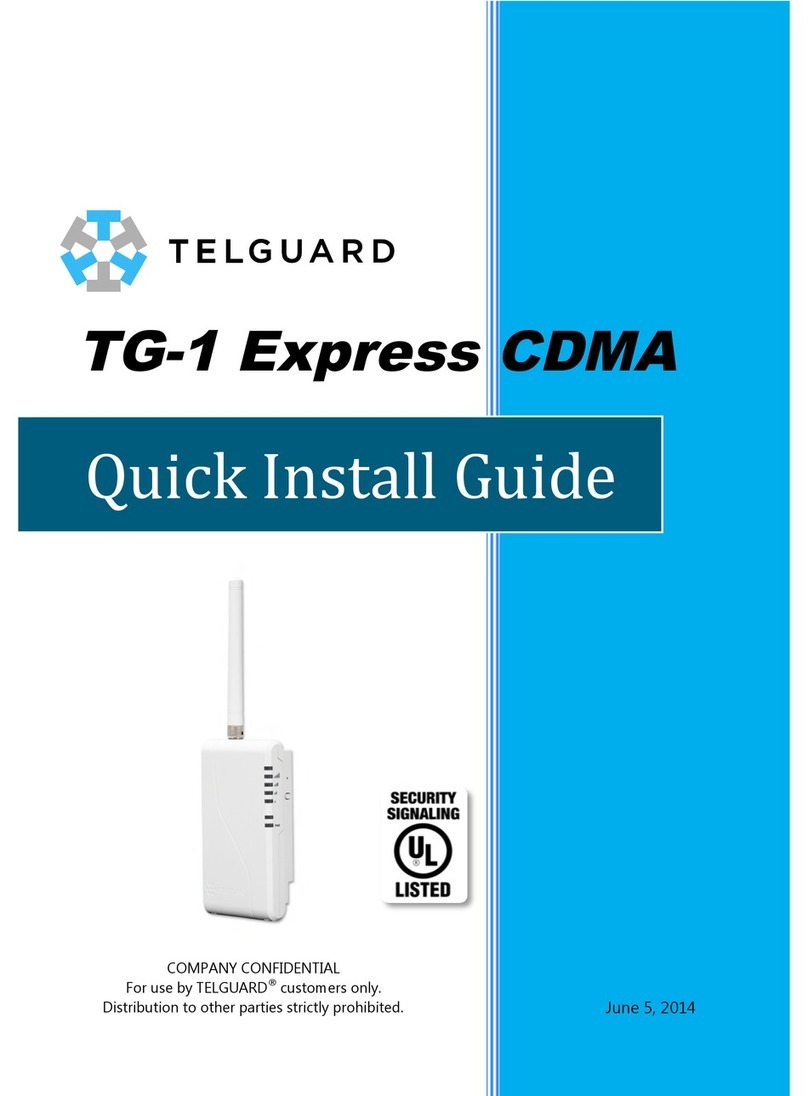
Telguard
Telguard TG-1 Express CDMA User manual
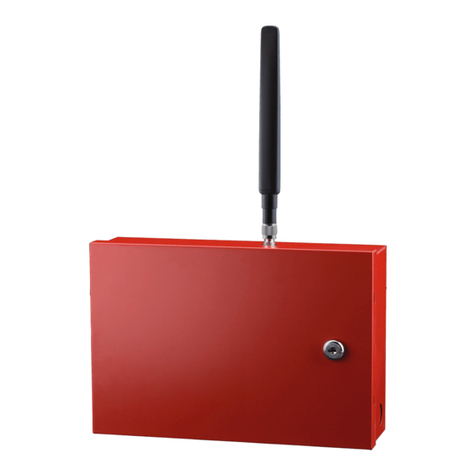
Telguard
Telguard Dual Path Series Troubleshooting guide
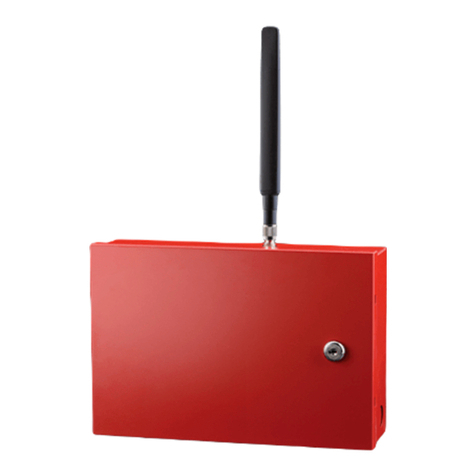
Telguard
Telguard TG-7 Series Troubleshooting guide
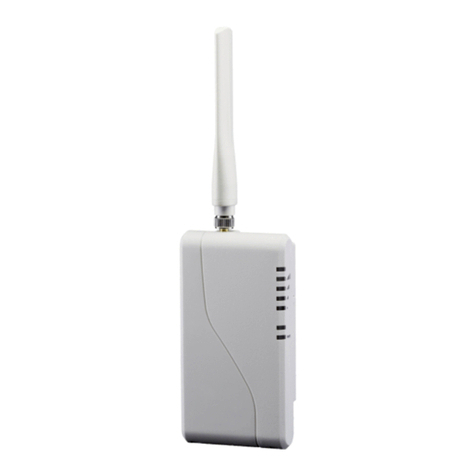
Telguard
Telguard TG-1 Express CDMA User manual

Telguard
Telguard TG-1 Express CDMA User manual
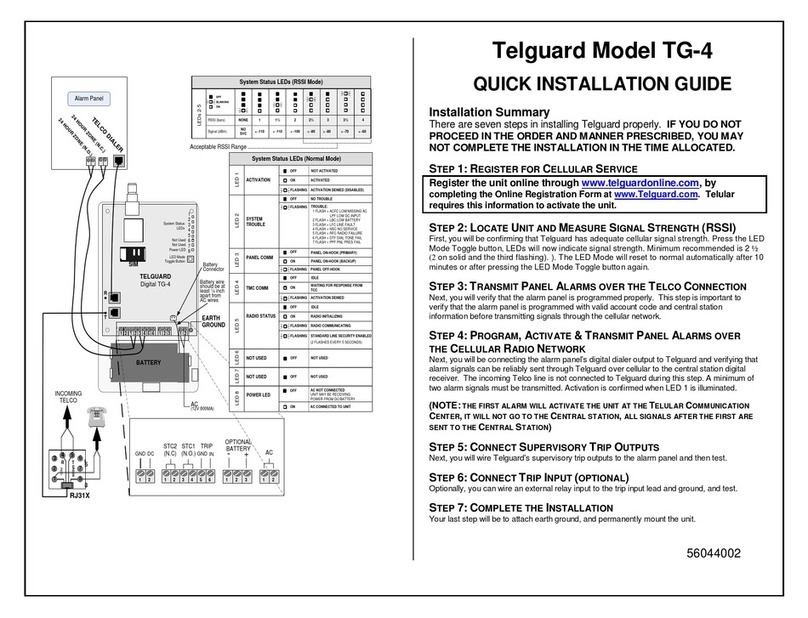
Telguard
Telguard TG-4 User manual
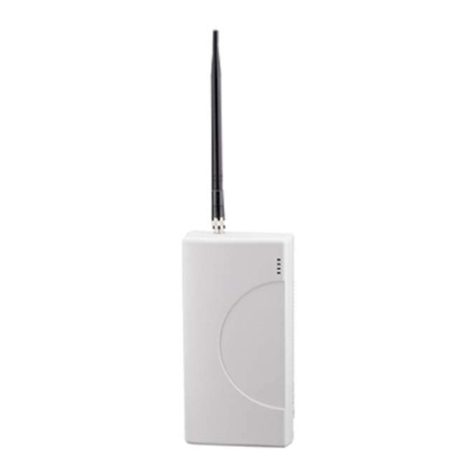
Telguard
Telguard TG-4 User manual
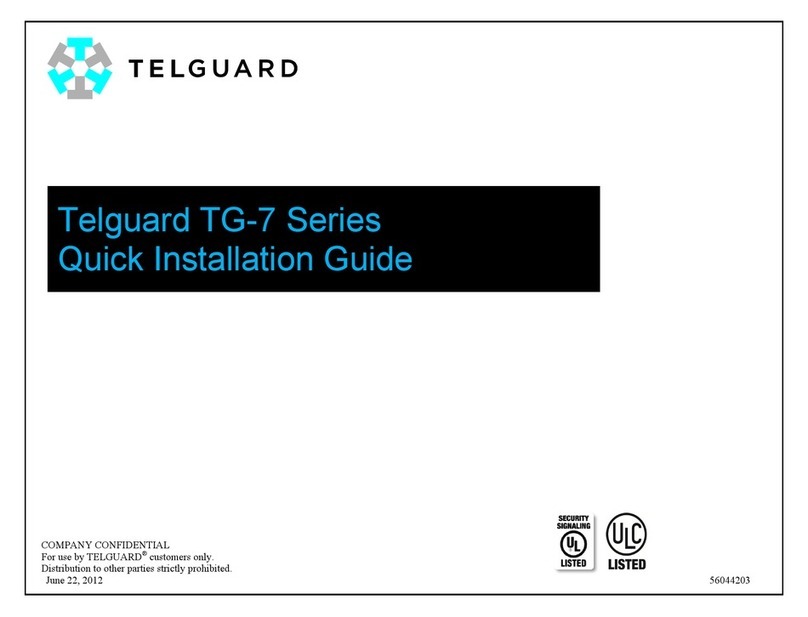
Telguard
Telguard TG-7 Series User manual
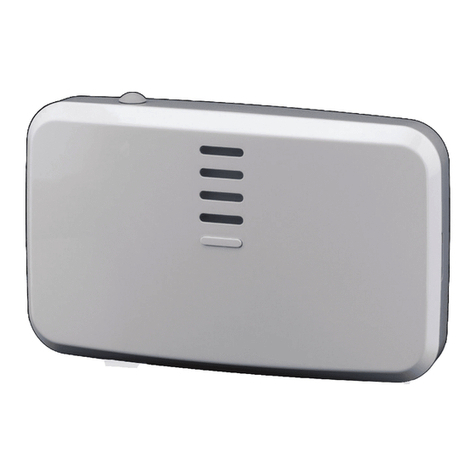
Telguard
Telguard TG-SCI Plus User manual

Telguard
Telguard TG-1 Express CDMA User manual
